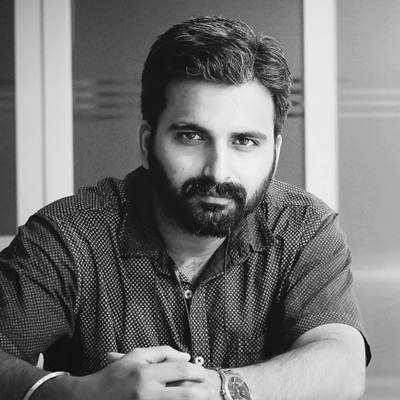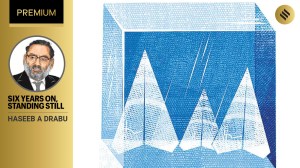In booming Hyderabad, a collective works for sustainable development
Fridays for Architecture and Urbanism hopes that by opening up a platform to discuss public spaces, the gap between the community and the government can be bridged.
 In architecture, the concept of context refers to how a building's components are understood in terms of its surroundings.
(Photo: Rahul Palagani)
In architecture, the concept of context refers to how a building's components are understood in terms of its surroundings.
(Photo: Rahul Palagani)As Hyderabad continues to expand by leaps and bounds, a small group of young professionals and enthusiastic citizens here are on a mission to set the context for development without losing the focus on sustainability for the future.
Hyderabad – a city founded in 1591 by the fifth Sultan of Golconda, Mohammed Quli Qutb Shah, is today one competing to be among the top global cities. The capital of Telangana, known for its cosmopolitan culture and far-sighted approach to urban planning and development set forth during the times of the last Nizam, Mir Osman Ali Khan, has witnessed rapid changes since the state formation in 2014.
 Fridays for Architecture and Urbanism (FAU) is conceived as a collective of architects, planners, students, historians, artists, urbanists, environmentalists, and enthusiasts in the city for discussing public spaces in the city with the local communities. (Photo: Rahul Palagani)
Fridays for Architecture and Urbanism (FAU) is conceived as a collective of architects, planners, students, historians, artists, urbanists, environmentalists, and enthusiasts in the city for discussing public spaces in the city with the local communities. (Photo: Rahul Palagani)
Thus, Fridays for Architecture and Urbanism (FAU) is conceived as a collective of architects, planners, students, historians, artists, urbanists, environmentalists, and enthusiasts in the city for discussing public spaces in the city with the local communities. “As a city, we are growing so fast and still we feel we are not designing for the public. What is happening looks great but the ground reality is that much more can be done than the superficial work,” says thirty-one-year-old Rahul Palagani, an architect and urbanist with a Master’s in Architectural Design in Heritage Context from Italy.
“Hyderabad is happening now. So much has changed and is still changing every day. We want to ask if it is sustainable. Good architecture does not have to be bling or expensive, it just needs to be right,” adds Siddharth Velamakanni, who holds a Master’s degree in Architecture from the US. Along with their partner Sasank IVS, an architect and historian, the group feels that they want to not only raise the right questions, bring about dialogue and help reach the solutions but also are equipped with the expertise, experience, and understanding of what they talk about.
#MirAlamMandi -the oldest market is all set to get the makeover @₹16.14crs, the nizam era market will be rebuilt & restored to its original grandeur; adding underground drain, paving & LED lighting
Tenders with COT & works likely to commence in Jan 2023@KTRTRS@asadowaisi pic.twitter.com/UdBolasZ7S— Arvind Kumar (@arvindkumar_ias) December 11, 2022
One of their recent meet-ups was at the city’s oldest market square, Mir Alam Mandi. The 200-year-old market has reached a stage where it can pose a threat to its habitants. The state government has proposed to restore the dilapidated Nizam-era market to its original glory in the next 18 months and set aside Rs 16.14 crore. “The community tells us they were never asked about their needs. It is clear that ‘problem chhat pe nahi, zamin mein hai’. The drainage and waste management, connectivity, and access are the biggest problems. We will prepare a report and send it to the government about problems and solutions,” says Rahul.
 In recent times, the Telangana government has been enthusiastic about reviving old markets, step wells, mansions, and iconic monuments to their original glory. (Photo Rahul Palagani)
In recent times, the Telangana government has been enthusiastic about reviving old markets, step wells, mansions, and iconic monuments to their original glory. (Photo Rahul Palagani)
In architecture, the concept of context refers to how a building’s components are understood in terms of its surroundings. “Without it, the architecture becomes moot. We are trying to understand the nuances of the requirements of the community. There should be enough research put into it,” adds Sasank. The group feels a culture of discussion on architecture is lacking in Hyderabad as compared to cities such as Delhi, Bengaluru, and Ahmedabad. Development should cater to a livable environment, they assert.
 The state government has proposed to restore the dilapidated Nizam-era market to its original glory in the next 18 months and set aside Rs 16.14 crore. (Photo: Rahul Palagani)
The state government has proposed to restore the dilapidated Nizam-era market to its original glory in the next 18 months and set aside Rs 16.14 crore. (Photo: Rahul Palagani)
In recent times, the Telangana government has been enthusiastic about reviving old markets, step wells, mansions, and iconic monuments to their original glory. The revival of Bansilalpet stepwell has been widely acclaimed and the project won the prestigious Big 5 Construction Impact Award in Dubai recently.
“The info center or visitors area with glass facade has no relation to the step well and it is overpowering the heritage. We are trying to understand from the community itself what they want to see. Whatever is being done should not be done haphazardly and that is what we are worried about,” adds Rahul, who has worked on conservation projects in Italy.
 The drainage and waste management, connectivity, and access are the biggest problems. We will prepare a report and send it to the government about problems and solutions,” says Rahul, an architect and urbanist with a Master’s in Architectural Design in Heritage Context from Italy. (Photo: Rahul Palagani)
The drainage and waste management, connectivity, and access are the biggest problems. We will prepare a report and send it to the government about problems and solutions,” says Rahul, an architect and urbanist with a Master’s in Architectural Design in Heritage Context from Italy. (Photo: Rahul Palagani)
According to Siddharth, the project does not become feasible unless the citizen is a stakeholder. “We need to see how a project can be self-functional and economically viable for the community. If it is not relevant, we need to ask if the development is even required,” he says. By opening up a platform for all to identify and discuss public spaces, they feel the gap between the community and the government could be bridged.
Talking about adaptive planning, the group has for now identified markets such as Murgi Chowk, another Nizam-era market that is set for redevelopment in the coming days, and macro-level issues such as the 1.32 lakh acres of land spread across 84 villages west of Hyderabad that is now available for real-estate with the state government revoking a 26-year-old order that restricted massive constructions in the catchment of two Nizam-era reservoirs. “We have such a scope for development here that we may not need any flyovers at all. There is no one way of doing anything,” says Rahul. “If the development can satisfy the commercial motive by keeping in mind ecological sustainability, it will be a win-win situation. For that, the knowledge needs to come ground-up,” notes Siddharth, underlining the need for development to blend into the environment and not become an interruption.













